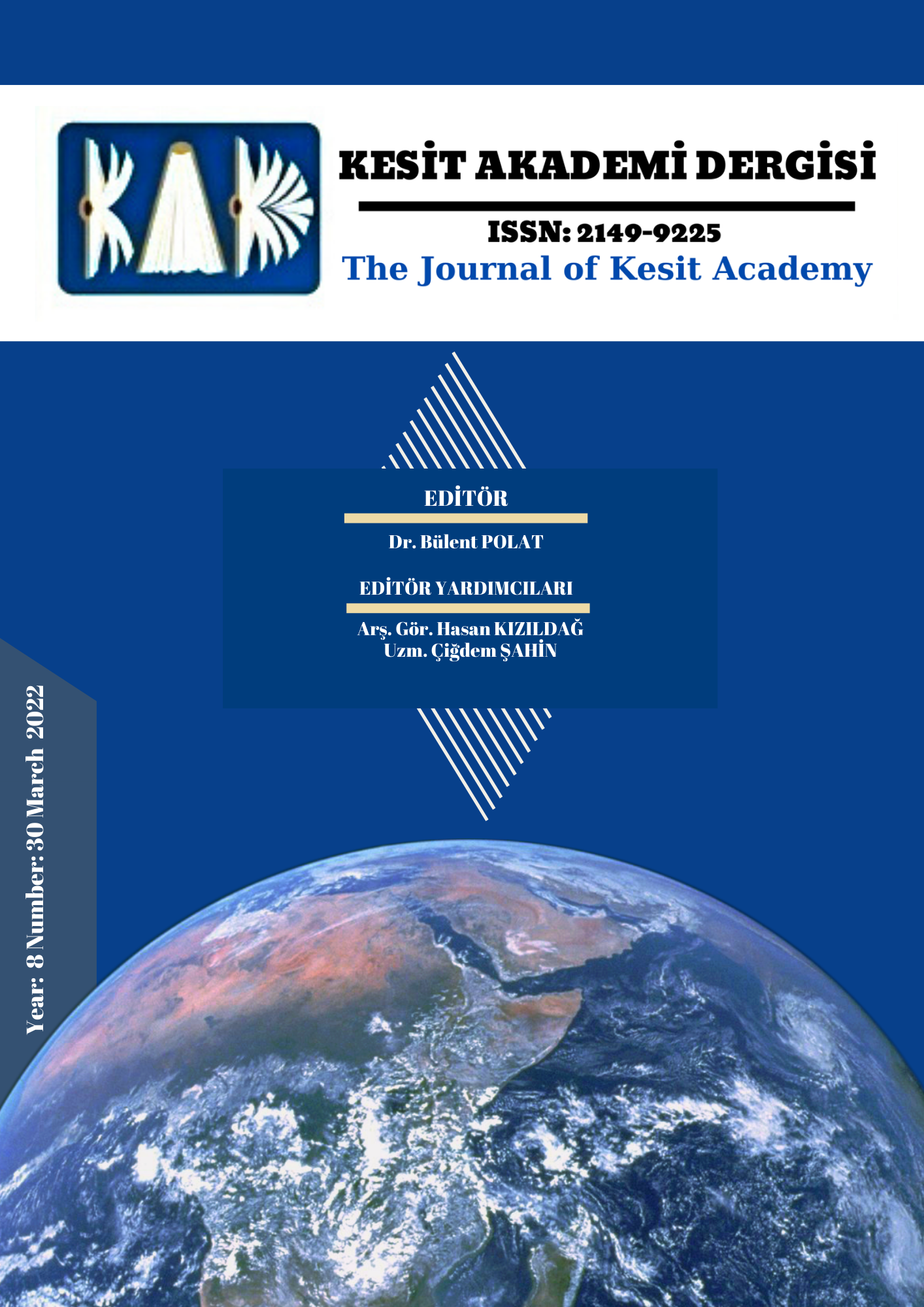Author :
Abstract
Mustafa Kutlu’nun 2011 yılında yayımlanan yirmi bir hikâyeden oluşan Hayat Güzeldir kitabındaki “Hayat Güzeldir” hikâyesi, “sevinç” duygusunun izleriyle okurunu baş başa bırakır. Hikâye, adı belirtilmeyen ana karakterin geçirdiği bir trafik kazası sonucu kendini ve yaşamı yeniden fark edişi üzerine kuruludur. Kişide var olan fakat ortaya çıkarılmayı, hatırlanmayı bekleyen “sevinç” duygusu kavramsal olarak “mutluluk”tan ayrılan özellikleriyle hikâyenin kurgusuna yerleşir. Ayrıca Kutlu’nun hikâyelerinde mutluluk yerine daha çok sevinç ya da sevinmek kelimelerinin kullanıldığı görülmektedir. Fakat “Hayat Güzeldir” hikâyesinin özellikle “sevinç”in beslendiği kaynak ve bakış açılarıyla uyumlu kurgusu, onu “sevinç” ve “mutluluk” kavramlarının karşıt anlam aralıklarından incelemeyi gerekli kılmıştır. Hikâyede adı belirtilmeyen ana karakterin yaşadığı bir trafik kazası sonucu kırmızı bir gelincikle burun buruna gelme anıyla başlayan olay örgüsü, onun yaşamı ve kendisini yeniden fark etme yolculuğunun başlangıcı hâline gelir. Ayrıca kent ile tabiat yaşamının belirgin farklılıklarını da okura sezdirmeyi ihmal etmeyen kurgu, temel karşıtlıklarını tabiat-kent ve sevinç-mutluluk üzerine inşa eder. Bu bağlamda hikâye, bir kısırdöngü içerisinde yaşanan mutluluk arayışının, “sevinç”i giderek gölgeleyen ve kişiyi hayatın hakikî güzelliklerinden mahrum eden bir tükenişe doğru sürükleme riskini dolaylı olarak ifade etmiş olur. Çalışmada hikâyenin tematik vurgusunun yoğunlaştığı “sevinç”in görünümlerine, anlamlarına ve özünde kesintiye uğramayan, sadece fark edilmeyi bekleyen yapısına yakından bakılacaktır. Mutluluğun ise geçici, kırılgan ve sürek-siz özellikleriyle “sevinç”in tabiattan, duygusal örüntülerden, içsel ve manevî deneyim alanlarından beslenen yapısı açıklanarak anlatıcının kitaba adını veren hayat güzeldir vurgusunun çoğalan anlamları ve iletileri üzerinde durulacaktır.
Keywords
Abstract
The story "Hayat Güzeldir" in Mustafa Kutlu's book “Hayat Güzeldir”, which consists of twenty-one stories published in 2011, focuses on the feeling of "joy." It is based on the story of the main character's, whose name is not given in the story, rediscovery of self after a traffic accident. The feeling of "joy," which is already there within the person waiting to be discovered and remembered, is embedded throughout the story with its conceptual differences from "happiness." It is also noteworthy that the words 'joy' and 'enjoyment' are used instead of the word 'happiness' in Kutlu's stories. Furthermore, the storyline of "Hayat Güzeldir," especially in harmony with the sources and perspectives related to "joy," makes it necessary to examine it from the perspective of opposite meanings of "joy" and "happiness." The plot, starting with the moment when the main character, whose name is not mentioned in the story, comes face to face with a red poppy as a result of a traffic accident, is the beginning of the main character's journey to rediscovery of life and self. In addition, the storyline, incorporating elements of the distinctive differences between urban and natural life, is built on the dualities of nature-city and joy-happiness. In this regard, the story indirectly asserts that the risk in pursuit of happiness, lived in a vicious circle, leads to exhaustion that gradually overshadows “joy” and deprives one of the true beauties of life. In this study, the appearances and meanings of “joy,” on which the theme of the story focuses, and its structure, uninterrupted in its essence, waiting to be discovered, will be examined in detail. On the other hand, with the temporary, fragile, and discontinuous characteristics of happiness, the structure of "joy" that is strengthened by nature, emotional patterns, and inner and spiritual experiences will be analyzed, and the multiplying meanings and messages of the narrator's emphasis on Hayat Güzeldir, the name of the book, will be discussed.
Keywords
- Alev, K. (2013). Mustafa Kutlu’nun hikâyelerinde dünya algısı. *Yayımlanmamış yüksek lisans tezi+. Fatih Sultan Mehmet Vakıf Üniversitesi Sosyal Bilimler Enstitüsü.
- Bauman, Z. (2021). Yaşam sanatı (Çev.: Akın Sarı) (6. Basım). Ayrıntı Yayınları.
- Borgna, E. (2020). Ruhun yalnızlığı (Çev.: Meryem Mine Çilingiroğlu) (6. Baskı). Yapı Kredi Yayınları.
- Csikszentmihalyi, M. (2021). Mutluluk bilimi (Çev.: Barış Satılmış) (8. Baskı). Buzdağı Yayınevi.
- Çoruk, A. Ş. (2013). Mustafa Kutlu Üzerine Bazı Dikkatler. Aynanın Sırrı Mustafa Kutlu Sempozyum Bildirileri (haz.: M. Fatih Andı, Bahtiyar Aslan), Küçükçekmece Belediyesi Kültür Yayınları, s. 39-44.
- Işık Koçak, A. (2013). Mustafa Kutlu’nun hikâyelerinde modern kentli insanın bunalımları *Yayımlanmamış yüksek lisans tezi+. Fatih Sultan Mehmet Vakıf Üniversitesi Sosyal Bilimler Enstitüsü.
- Karataş, T. (2013). Mustafa Kutlu’nun kısa hikâyelerindeki ileti. Aynanın Sırrı Mustafa Kutlu Sempozyum Bildirileri (haz.: Prof. Dr. M. Fatih Andı, Yrd. Doç. Dr. Bahtiyar Aslan), Küçükçekmece Belediyesi Kültür Yayınları, s. 317-321.
- Kutlu, M. (2020). Sevincini bulmak (6. Baskı). Dergâh Yayınları.
- Kutlu, M. (2021). Hayat güzeldir (22. Baskı). Dergâh Yayınları.
- Şimşek, Y. (2018). Hayat Güzeldir Eseri Bağlamında Mustafa Kutlu Hikâyesinde Kuş ve Çiçek İmgesi. Sosyal Bilimler Araştırmaları Dergisi. 13/1, s. 123-140. http://dx.doi.org/10.19129/sbad.348
- Tosun, N. (2021). Türk öykücülüğünde Mustafa Kutlu (2. Baskı). Dergâh Yayınları.
- Weil, S. (2019). Yer çekimi ve inayet (Çev.: M. Mukadder Yakupoğlu). Doğu Batı Yayınla- rı.





